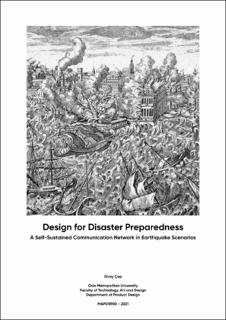Design for disaster preparedness: A self-sustained communication network in earthquake scenarios
Master thesis
Published version
Permanent lenke
https://hdl.handle.net/11250/2768747Utgivelsesdato
2021Metadata
Vis full innførselSamlinger
Sammendrag
Design solution I am proposing here consists of an application interface
for the disaster victims and an underlying communication network
solution that can self-sustain by building a mesh network between the
mobile devices that are in the disaster area. This new network comes
into play when the existing internet or GSM network fails.
Aim of this project is to strengthen the communication between
the citizens themselves as well as between the citizens and the
governments civil defense organizations.
I was inspired to work on this topic as my home country, Turkey, is
prone to earthquakes and has suffered multiple disasters in the past.
Personally, I have great motivation to introduce design solutions in the
area of natural disasters because I believe there is great potential to
improve, and every step is important in the way to create a prepared
society, social systems and governments.
Project begins with the research question on how to sustain the
communication network in the case of a natural disaster.
Initial research consists of reading through literature, news sources, and
internet sources of government organizations. This is to understand
the risks, nature of an earthquake scenario, and how different systems
in a city interacts with each other. Initial research is combined with
Gigamapping method to create a gigamap of the earthquake
scenario. Consisting of before, during the disaster and the situation
after.
Research part has multiple additional categories as well; reading on
existing technologies to understand how some communication systems
work and going through social media websites of a selected time
frame.
The research was followed by interviews. I used the initial gigamap as
a reference during the interviews to make it easy for the attendants
to visualize and propose solutions. Those solutions and then used to
generate first concepts and follow up interviews were used to get
feedback on the concepts.
The final design solution was shaped after the feedback sessions.
Materials used in this project was mainly limited to digital, this is due to
nature of the project as well as the global pandemic that was taking
place while this project were in progress. Interviews were held through
video and audio calls, also screen-sharing and digital white-board
were used.
I think this project has an advantage of timing, digitalization is very on
demand currently and I believe the design solution explored here has
the potential to attract attention of the right organizations.
